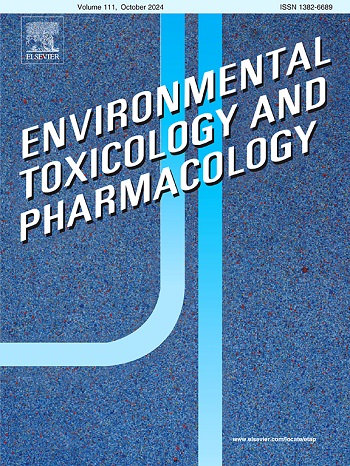Toxicity assessment of effluent from a potato-processing industry in Cyprinus carpio
IF 4.2
3区 环境科学与生态学
Q2 ENVIRONMENTAL SCIENCES
引用次数: 0
Abstract
Potato (Solanum tuberosum) cultivation faces the challenge of excessive pesticide use. During processing, the disposal of large volumes of contaminated water into water bodies can result in severe environmental damage, such as fish deaths. This study aimed to evaluate the toxicological effects of chemical compounds present in the effluent from a potato-processing industry using the test organism Cyprinus carpio. The liver, gills, muscles, and brain were analyzed for biochemical parameters such as catalase (CAT), superoxide dismutase (SOD), acetylcholinesterase (AChE), and lipid peroxidation (TBARS). The highest quantities of pesticides found in the effluent were atrazine, azoxystrobin, fipronil, flutolanil, imidacloprid, tebuconazole, and thiamethoxam. Fish were exposed to the effluent for 7, 14, and 28 days in the laboratory. The CAT enzyme increased activity in the gills at 7 (p-value=0.000) and 14 days (p-value=0.003). Lipid peroxidation showed an increase in the gills at seven days (p-value=0.0281) and in the liver at 7 (p-value=0.000) and 14 days (p-value=0.000). There was also a significant increase (p-value=0.000) in AChE activity in the muscle at all periods. This result highlights the environmental risk and toxicity of potato effluent containing pesticide residues, which can cause biochemical damage to C. carpio and other living organisms.
鲤鱼马铃薯加工业废水的毒性评价。
马铃薯(Solanum tuberosum)种植面临农药过量使用的挑战。在加工过程中,将大量受污染的水排入水体会造成严重的环境破坏,例如鱼类死亡。本研究旨在利用试验生物鲤鱼(Cyprinus carpio)评价马铃薯加工工业废水中化合物的毒理学效应。分析肝脏、鳃、肌肉和脑的生化参数,如过氧化氢酶(CAT)、超氧化物歧化酶(SOD)、乙酰胆碱酯酶(AChE)和脂质过氧化(TBARS)。在污水中发现的最高农药含量是阿特拉津、嘧菌酯、氟虫腈、氟唑尼、吡虫啉、戊唑唑和噻虫嗪。鱼在实验室中分别暴露在污水中7、14和28天。CAT酶在第7天(p值=0.000)和第14天(p值=0.003)提高了鱼鳃的活性。鳃脂质过氧化在第7天增加(p值=0.0281),肝脏脂质过氧化在第7天和第14天增加(p值=0.000)。各时期肌肉中乙酰胆碱酯酶活性也显著升高(p值=0.000)。这一结果强调了含有农药残留的马铃薯废水的环境风险和毒性,它可以对鲤鱼和其他生物造成生化损害。
本文章由计算机程序翻译,如有差异,请以英文原文为准。
求助全文
约1分钟内获得全文
求助全文
来源期刊
CiteScore
7.00
自引率
4.70%
发文量
185
审稿时长
34 days
期刊介绍:
Environmental Toxicology and Pharmacology publishes the results of studies concerning toxic and pharmacological effects of (human and veterinary) drugs and of environmental contaminants in animals and man.
Areas of special interest are: molecular mechanisms of toxicity, biotransformation and toxicokinetics (including toxicokinetic modelling), molecular, biochemical and physiological mechanisms explaining differences in sensitivity between species and individuals, the characterisation of pathophysiological models and mechanisms involved in the development of effects and the identification of biological markers that can be used to study exposure and effects in man and animals.
In addition to full length papers, short communications, full-length reviews and mini-reviews, Environmental Toxicology and Pharmacology will publish in depth assessments of special problem areas. The latter publications may exceed the length of a full length paper three to fourfold. A basic requirement is that the assessments are made under the auspices of international groups of leading experts in the fields concerned. The information examined may either consist of data that were already published, or of new data that were obtained within the framework of collaborative research programmes. Provision is also made for the acceptance of minireviews on (classes of) compounds, toxicities or mechanisms, debating recent advances in rapidly developing fields that fall within the scope of the journal.

 求助内容:
求助内容: 应助结果提醒方式:
应助结果提醒方式:


